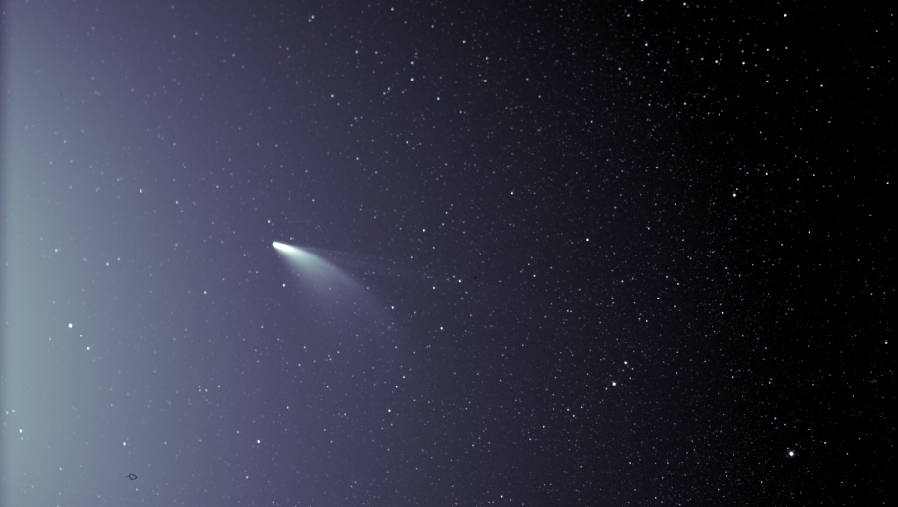(单词翻译:单击)
听力文本
Comet "Neowise" Provides Light Shows while Passing by Earth
Comets are solar system objects made up of ice, rock and dust. Right now, a newly-discovered one is speeding by Earth, providing excellent light shows for the planet's people.
The ice-rock is called Neowise. It is the brightest comet to appear above the Northern Hemisphere in 25 years. Social media users in many countries have posted images they captured of Neowise, as it lit up the sky over their heads.
Comets are normally about 8 to 16 kilometers wide. But, as they travel near the sun, they heat up, releasing gas and dust. The comet expands to form a "glowing head that can be larger than a planet," says the U.S. space agency NASA. The process also creates a sunlit "tail" of dust. It can stretch for millions of kilometers behind the comet.
Scientists say Neowise is believed to be about 5 kilometers across. It passed inside Mercury's orbit on July 3, NASA's Jet Propulsion Laboratory said in a statement. The close pass by the sun was "cooking" the comet's outermost parts, causing a major release of gas and dust material. "And yet the comet has managed to survive this intense roasting," the statement said.

The comet was named for NASA's NEOWISE infrared space telescope, which discovered it in March. The NEOWISE project aims to search the skies for what scientists call near-Earth objects, or NEOs. Such objects include asteroids and comets that could come within 50 million kilometers of Earth's orbit.
In this case, NASA said Neowise would pass by Earth "at a harmless distance of 103 million kilometers," while giving astronomers a good chance to study its substance and structure.
Sky watchers may be able to see Neowise as it passes through the inner solar system. But "its nearness to the sun" could make sighting it difficult, NASA says.
Experts say people in the Northern Hemisphere — the part of Earth above the equator — should look toward the northwestern sky, just below the "Big Dipper" star group.
Until recently, the best time to see Neowise was about an hour before sunrise. This week, the comet began making its appearance in the evening sky shortly after sunset.
People have been able to see the head of the comet without the use of equipment. But devices like binoculars and telescopes are better for viewing the comet's long tail.
Neowise is expected to be seeable across the Northern Hemisphere until mid-August. It will then start making its way back to the outer parts of the solar system.
NASA says it will be about 7,000 years before the comet returns. "So I wouldn't suggest waiting for the next pass," said Joe Masiero of NASA's Jet Propulsion Laboratory.
Astronauts on the International Space Station caught a good look at the bright ice-rock last week. NASA's Bob Behnken captured an image of Neowise and shared the picture on social media.
It shows central Asia in the background, and part of the space station in the foreground. "Stars, cities, spaceships, and a comet!" Behnken tweeted from orbit.
I'm Bryan Lynn.
重点解析
重点讲解:
1. be made up of (由…)构成的;(由…)制成的;
Food is made up of carbohydrates, proteins and fats.
食物由碳水化合物、蛋白质和脂肪构成。
2. light up 照亮;发亮;
There was an explosion and the whole sky lit up.
一声爆炸照亮了整个天空。
3. heat up 变热;
In the summer her mobile home heats up like an oven.
夏天一到,她的活动住房就变得像烤炉一样热。
4. wait for 等待;等候;
As soon as they've finished up, they kick back and wait for the next show.
他们一完工就开始休息并等待下一场演出。
参考译文
彗星Neowise经过地球时上演灯光秀
彗星是由冰、岩石和尘埃组成的太阳系天体。现在,一颗新发现的彗星正在迅速飞越地球,为地球上的人们上演无与伦比的灯光秀。
这块冰岩名为Neowise。它是25年来出现在北半球上空的最亮彗星。许多国家的社交媒体用户都上传了他们拍到的Neowise彗星点燃他们头顶那片天空的照片。
彗星一般宽约8到16公里。但是,当它们靠近太阳时,它们的温度会升高,释放出气体和灰尘。美国太空机构国家航空航天局(简称NASA)表示,彗星会膨胀成“比行星还要大的发光球”。这一过程还会产生阳光照射下的尘埃尾。这一尘埃尾可以在彗星后面绵延数百万公里。
科学家表示,据悉 Neowise彗星的直径约为5公里。美国国家航空航天局旗下的喷气推进实验室在声明中表示,这颗彗星于7月3日掠过水星轨道内侧。近距离经过太阳正在“烘烤”这颗彗星的最外层,导致气体和尘埃物质大量释放。声明表示,这颗彗星成功挺过了这场剧烈烘烤。
这颗彗星于今年3月被发现,以NASA的广域红外勘测探测器太空望远镜命名。NEOWISE项目的目标是在天空中搜寻科学家称为“近地天体”(简称NEO)的物体。这类天体包括距离地球轨道5000万公里以内的小行星和彗星。
NASA表示,在这种情况下,Neowise彗星将以“1.03亿公里的无害距离”飞越地球,同时为天文学家提供研究其物质和结构的大好机会。
Neowise彗星穿过太阳系内部时,天文观测者也许能看到它。但NASA表示,由于“它离太阳很近”,可能会使观测变得困难。
专家表示,北半球,即地球赤道以北地区的民众应该向西北方向的天空看,锁定“北斗七星”群的正下方。
直至最近,观测Neowise彗星的最佳时间都在日出前一小时左右。而本周,这颗彗星开始在日落后不久出现在夜空。
人们能在不使用设备的情况下看到彗星的头部。但双筒望远镜和望远镜这样的设备更适合观测彗星长长的尾巴。
预计整个北半球在8月中旬前都可以看到Neowise彗星。之后,该彗星将开始返回太阳系外围。
NASA表示,这颗彗星约7000年后才会再次回归。NASA喷气推进实验室的乔·马西罗表示,“所以我不建议等待它下一次经过。”
上周,国际空间站的宇航员清楚地看到了这颗明亮的冰岩。NASA宇航员鲍勃·本肯拍摄了一张Neowise彗星的照片,并将其分享到社交媒体上。
照片的背景是中亚,前景是国际空间站的一部分。本肯在国际空间站的轨道上发推称,“星星、城市、宇宙飞船和彗星!”
布莱恩·林恩报道。
译文为可可英语翻译,未经授权请勿转载!


